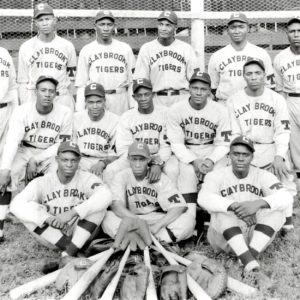calsfoundation@cals.org
Claybrook Tigers Baseball Team
An African American semi-professional baseball team located in eastern Arkansas during the 1930s, the Claybrook Tigers played and often beat some of the best Negro League teams around. The small Delta town known as Claybrook, in the southern part of Crittenden County, was an unlikely home for a competitive baseball team. It no longer exists, but at that time it was the farming and logging operation of John C. Claybrook, a hard-working and enterprising man who became one of the most successful Black businessmen in the region. Reportedly, Claybrook formed the team to entice his sports-loving son not to leave the farm for the city life he desired.
By the early 1930s, Claybrook had built a stadium on the farm and formed the baseball team, costing him about $4,000. Some of the players worked on the farm, while others were professional players who played for any team willing to pay for their services. Claybrook and his son signed a number of athletes who went on to become successful Negro League players, including native Arkansan Theolic “Fireball” Smith, Dan Wilson, Walter Calhoun, John “The Brute” Lyles, Logan “Eggie” Hensley, Alfred “Greyhound” Saylor, Roosevelt “Bill” Tate, and W. H. “Big Train” Summerall. The most famous Tiger was Ted “Double Duty” Radcliffe, who managed and played for the team in 1936. Radcliffe was well known for moving around the country playing for anyone willing to give him the best deal. He was dubbed “Double Duty” because he often pitched the first game of a double-header and played catcher in the second game. He often did this while managing his team, too. (Radcliffe died on August 11, 2005, at the age of 103. He had been the oldest living Negro League player.)
During the mid-1930s, the Claybrook Tigers participated in the Negro Southern League and were league champions in 1935 and 1936. Their major competitor was the Memphis Red Sox, though they also played and defeated well-known traveling Negro League teams, including the Pittsburgh Crawfords, Chicago American Giants, Cuban All-Stars, Cincinnati Tigers, and Kansas City Monarchs. The Tigers had a stadium in Claybrook but played many of their home games in Memphis. Memphis’s Commercial Appeal reported in 1935 that the Tigers were “probably the best drawing card in the southern circle.” They attracted crowds equal to or larger than those generated by teams visiting from major cities such as Cincinnati, Birmingham, and Atlanta. During a one-month period in 1935, they drew an average attendance of 2,000 at the Memphis and Claybrook parks. It was common for large groups of Memphians to attend games in Claybrook.
Founder John C. Claybrook took great pride in his team. Marlin Carter, a former Negro League player, recalled that Claybrook readily spent money on his team: “When it came to the baseball team, he did everything first class!” This included paying his players, hiring Radcliffe, buying nice uniforms, and even purchasing suits for the players to wear when they traveled.
Information on the Claybrook Tigers is sparse, especially regarding the demise of the team. It appears the team folded after the 1937 season, when it virtually disappears from the local newspapers. One reason may be that around this time, shortly after the 1936 season, Radcliffe took some of Claybrook’s best players with him to play for the Cincinnati Tigers, where he managed and played in 1937. A number of other good players went to the Pittsburgh Crawfords that year.
Though the Claybrook Tigers played only a short time, the team projected the commitment and determination to succeed that was so present in its owner. The Tigers also provided the opportunity for not only well-known players but also some up-and-coming Negro League stars to play the game they loved.
For additional information:
Dawson, David D, director. Swingin’ Timber. VHS, DVD. Fayetteville: University of Arkansas Lemke Department of Journalism, 2001.
Ivy, Darren. “Timber Team.” Arkansas Democrat-Gazette, July 4, 2002, p. 1C.
Pyle, Ernie. Home Country. New York: William Sloane Associates, Inc., 1947.
David D. Dawson
University of Arkansas, Fayetteville
 Early Twentieth Century, 1901 through 1940
Early Twentieth Century, 1901 through 1940 Recreation and Sports
Recreation and Sports Claybrook Tigers
Claybrook Tigers  Claybrook Tigers Ad
Claybrook Tigers Ad 



Comments
No comments on this entry yet.